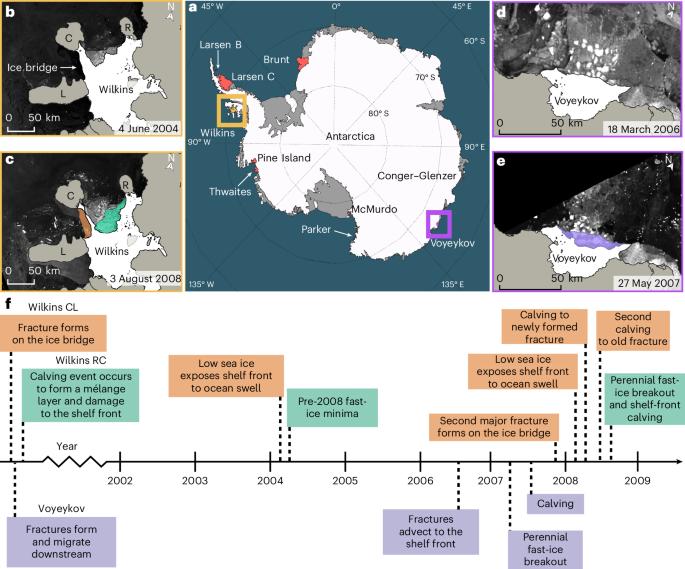Large-scale ice-shelf calving events follow prolonged amplifications in flexure
IF 16.1
1区 地球科学
Q1 GEOSCIENCES, MULTIDISCIPLINARY
引用次数: 0
Abstract
The retreat of Antarctic ice shelves due to calving and the subsequent reduction in buttressing of the Antarctic Ice Sheet are of major concern for future sea-level rise. Sudden, widespread calving of weakened ice shelves has been linked to fracture amplification forced by ocean swell following regional sea-ice losses, but increases in the magnitudes and durations of swell-induced ice-shelf flexure in the lead-ups to calving events have not been tracked. Here we present 7-year datasets of sea-ice-barrier lengths and shelf-front flexural stress that encompass large-scale calving events for the Wilkins and Voyeykov ice shelves. We find that the ice shelves exhibit similar preconditioning patterns, characterized by prolonged amplifications in flexure and the collapse of adjoining fast-ice barriers. We propose a conceptual model for the swell–sea-ice–shelf-front conditions that lead to calving events, show that it fits other major calving events and discuss the likely importance of sea-ice loss for the future of ice shelves. The loss of sea ice enhances swell-induced flexural stress in Antarctic ice shelves before large-scale calving events, according to satellite observations and swell-induced flexural stress modelling.


大规模的冰架崩解事件发生在长时间的弯曲放大之后
南极冰架因崩解而退缩以及随后的南极冰盖支撑力减少是未来海平面上升的主要问题。脆弱冰架的突然、广泛的崩解与区域海冰损失后海洋膨胀导致的断裂放大有关,但在崩解事件发生之前,膨胀引起的冰架弯曲的幅度和持续时间的增加尚未得到追踪。在这里,我们提供了7年的海冰屏障长度和大陆架前弯曲应力数据集,这些数据集涵盖了威尔金斯和沃耶科夫冰架的大规模裂冰事件。我们发现冰架表现出类似的预调节模式,其特征是弯曲的延长放大和相邻快速冰屏障的崩塌。我们提出了一个导致冰裂事件的浮海冰架前沿条件的概念模型,表明它适合其他主要的冰裂事件,并讨论了海冰损失对冰架未来的可能重要性。
本文章由计算机程序翻译,如有差异,请以英文原文为准。
求助全文
约1分钟内获得全文
求助全文
来源期刊

Nature Geoscience
地学-地球科学综合
CiteScore
26.70
自引率
1.60%
发文量
187
审稿时长
3.3 months
期刊介绍:
Nature Geoscience is a monthly interdisciplinary journal that gathers top-tier research spanning Earth Sciences and related fields.
The journal covers all geoscience disciplines, including fieldwork, modeling, and theoretical studies.
Topics include atmospheric science, biogeochemistry, climate science, geobiology, geochemistry, geoinformatics, remote sensing, geology, geomagnetism, paleomagnetism, geomorphology, geophysics, glaciology, hydrology, limnology, mineralogy, oceanography, paleontology, paleoclimatology, paleoceanography, petrology, planetary science, seismology, space physics, tectonics, and volcanology.
Nature Geoscience upholds its commitment to publishing significant, high-quality Earth Sciences research through fair, rapid, and rigorous peer review, overseen by a team of full-time professional editors.
 求助内容:
求助内容: 应助结果提醒方式:
应助结果提醒方式:


